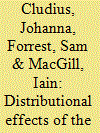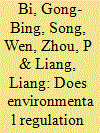|
|
|
Sort Order |
|
|
|
Items / Page
|
|
|
|
|
|
|
| Srl | Item |
| 1 |
ID:
132621


|
|
|
|
|
| Publication |
2014.
|
| Summary/Abstract |
The Australian Renewable Energy Target (RET) has spurred significant investment in renewable electricity generation, notably wind power, over the past decade. This paper considers distributional implications of the RET for different energy users. Using time-series regression, we show that the increasing amount of wind energy has placed considerable downward pressure on wholesale electricity prices through the so-called merit order effect. On the other hand, RET costs are passed on to consumers in the form of retail electricity price premiums. Our findings highlight likely significant redistributive transfers between different energy user classes under current RET arrangements. In particular, some energy-intensive industries are benefiting from lower wholesale electricity prices whilst being largely exempted from contributing to the costs of the scheme. By contrast, many households are paying significant RET pass through costs whilst not necessarily benefiting from lower wholesale prices. A more equitable distribution of RET costs and benefits could be achieved by reviewing the scope and extent of industry exemptions and ensuring that methodologies to estimate wholesale price components in regulated electricity tariffs reflect more closely actual market conditions. More generally, these findings support the growing international appreciation that policy makers need to integrate distributional assessments into policy design and implementation.
|
|
|
|
|
|
|
|
|
|
|
|
|
|
|
|
| 2 |
ID:
128027


|
|
|
|
|
| Publication |
2014.
|
| Summary/Abstract |
Data envelopment analysis (DEA) has gained much popularity in performance measurement of power industry. This paper presents a slack-based measure approach to investigating the relationship between fossil fuel consumption and the environmental regulation of China's thermal power generation. We first calculate the total-factor energy efficiency without considering environmental constraints. An environmental performance indicator is proposed through decomposing the total-factor energy efficiency. The proposed approach is then employed to examine whether environmental regulation affects the energy efficiency of China's thermal power generation. We find that the environmental efficiency plays a significant role in affecting energy performance of China's thermal generation sector. Decreasing the discharge of major pollutants can improve both energy performance and environmental efficiency. Besides, we also have three main findings: (1) The energy efficiency and environmental efficiency were relatively low. (2) The energy and environmental efficiency scores show great variations among provinces. (3) Both energy efficiency and environmental efficiency are of obvious geographical characteristics. According to our findings, we suggest some policy implications.
|
|
|
|
|
|
|
|
|
|
|
|
|
|
|
|
| 3 |
ID:
127903


|
|
|
|
|
| Publication |
2014.
|
| Summary/Abstract |
This study explores factors related to energy consumers' perceptions of government subsidies for utility provided energy efficiency (EE) programs and for utility providers' use of more clean/alternative energy sources. Demographic factors, attitudes, planned purchases, and perceptions of utility provider motives in relation to governmental and utility provider EE initiatives (i.e. providing discounts and coupons for CFL bulbs), plus the influence of gain- and loss-framed messages are investigated. Over 2000 respondents completed a 16 item phone survey. Hierarchical regression explained 38% of the variance in reactions regarding government subsidies of the cost of utility provided EE programs and 43% of the variance in perceptions involving whether utility companies should use of more clean or alternative forms of energy. Gender and party differences emerged. Loss-framed messages were more important when the issue was government subsidies. Both gain- and loss-framed messages were important when clean/alternative energy was the issue.
|
|
|
|
|
|
|
|
|
|
|
|
|
|
|
|
| 4 |
ID:
127908


|
|
|
|
|
| Publication |
2014.
|
| Summary/Abstract |
We seek to evaluate the extent of the pass through of increased fuel and carbon costs to wholesale prices with a shift of generation from coal-fired to gas-fired plants. Modelling of Australia's National Electricity Market in 2035 is undertaken using Australian Energy Market Operator assumptions for fuel costs, capital costs and demand forecasts. An electricity market simulation package (PLEXOS), which uses deterministic linear programming techniques and transmission and generating plant data, is used to optimize the power system and determine the least cost dispatch of generating resources to meet a given demand. We find that wholesale market prices increase due to the full pass through of the increased costs of gas over coal as an input fuel and the Carbon Price. In addition, we find that wholesale prices increase by more than the pass through of fuel and carbon costs because of the fact that generators can charge infra-marginal rents and engage in strategic behaviour to maximize their profits.
|
|
|
|
|
|
|
|
|
|
|
|
|
|
|
|
| 5 |
ID:
128005


|
|
|
|
|
| Publication |
2014.
|
| Summary/Abstract |
The Belgian nuclear phase-out law imposes closing down in the 2015-2025 period seven nuclear power plants (NPPs) producing more than 50% of the domestic electricity. This creates an urgent problem in the country because of the absence of well-defined capacity-replacement plans. Though a safety-of-supply provision in the law allows for a delayed phase-out, hopes for a technically acceptable schedule have reduced after the Fukushima nuclear disaster in March 2011. In this article policy investigations are made with system dynamics. A significant finding from such modelling is that, in contrast to common expectations, a too early nuclear phase-out will not serve the deployment of renewable energy sources and rational use of energy. It is indeed found to primarily benefit to fossil fuel, creating unwanted drawbacks regarding safety of supply, dependency on foreign suppliers, price volatility, and increased use of non-renewable and CO2-emitting fossil fuels.
|
|
|
|
|
|
|
|
|
|
|
|
|
|
|
|
| 6 |
ID:
127999


|
|
|
|
|
| Publication |
2014.
|
| Summary/Abstract |
Around the world there is increasing interest from government and industry in the potential for Carbon Capture and Storage (CCS) technologies to play a part in decarbonisation. This paper examines how people with little previous exposure to CCS technology, frame and discuss it, and how in the absence of information, ideas, notions, values and experiences shape opinion. We present data from a series of focus groups held with environmental activists, planning councillors, and adult and youth community group members in London in 2012. We found that views on CCS are shaped strongly by wider factors, particularly trade offs between different energy futures. Lay-critiques were similar to those put forward by environmental groups and were strongly framed by conceptions of nuclear power. We argue that although there is little public disquiet concerning this technology in private opinions were generally negative. This, and the use of nuclear power as a framing device, may present a challenge to policy-makers and industry committed to implementing CCS while promoting education as the main mechanism for public acceptance.
|
|
|
|
|
|
|
|
|
|
|
|
|
|
|
|
| 7 |
ID:
129364


|
|
|
|
|
| Publication |
2012.
|
| Summary/Abstract |
With the need for alternative sources of energy on the rise, especially in recent years, it is no surprise that the defence sector can be one of the largest consumer of solar power in India.
|
|
|
|
|
|
|
|
|
|
|
|
|
|
|
|
| 8 |
ID:
128023


|
|
|
|
|
| Publication |
2014.
|
| Summary/Abstract |
Niagara Falls and the Niagara River have always attracted great public interest due to their natural beauty, their enormous potential for electricity generation, their recreational value and as an important ecosystem. There have been simultaneous efforts to preserve this unique natural wonder and harness its power through hydroelectric development projects by both the United States and Canada. This paper explores the evolution of these efforts that culminated with the signing of the 1950 Niagara River Water Diversion Treaty that established minimum water flow rates to protect the "scenic beauty" of the falls, allowing the remaining water to be diverted for power production. We examine the rationale that led to specific water flow restrictions and question to what extent they are relevant today, as water intake capacity on the Canadian side has just been extended by around 25%. We find that current restrictions under the Niagara River Water Treaty (that expired in 2000) are not based on sound scientific evidence and estimate the upper limit of potential foregone benefits from clean electricity generation and greenhouse gas reductions. We identify a number of important issues that emerged in the last decades and that would justify an exploration of new treaty rules.
|
|
|
|
|
|
|
|
|
|
|
|
|
|
|
|
|
|
|
|
|